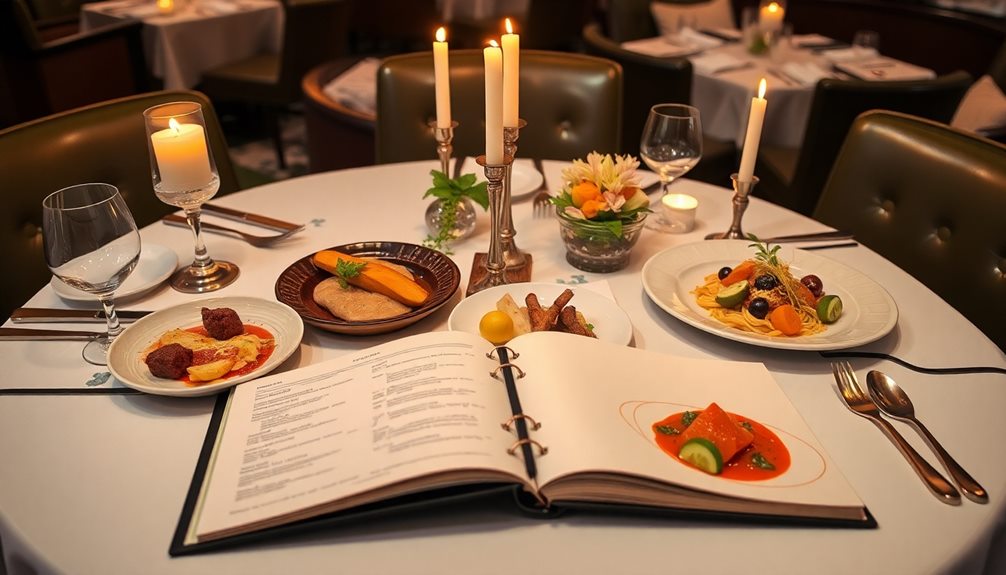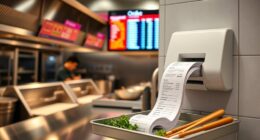To boost your restaurant’s local SEO, first claim and verify your Google My Business listing, ensuring all details are accurate and consistent across platforms. Incorporate local keywords naturally into your website content, highlight nearby landmarks, and engage with your community through events and social media. Encourage reviews, respond professionally, and build backlinks from local sites. Focus on mobile optimization and structured data, and if you keep moving forward, you’ll uncover even more effective tactics to attract nearby diners.
Key Takeaways
- Claim, verify, and maintain accurate Google My Business listings with consistent NAP details across all platforms.
- Incorporate local keywords, landmarks, and community references naturally into website content for better local relevance.
- Highlight proximity to local attractions and organize community events to boost local engagement and visibility.
- Build local authority through backlinks from reputable community sites and actively manage customer reviews.
- Regularly review and update listings and website content to ensure accuracy and optimize for voice search and structured data.
Claim and Optimize Your Google My Business Listing
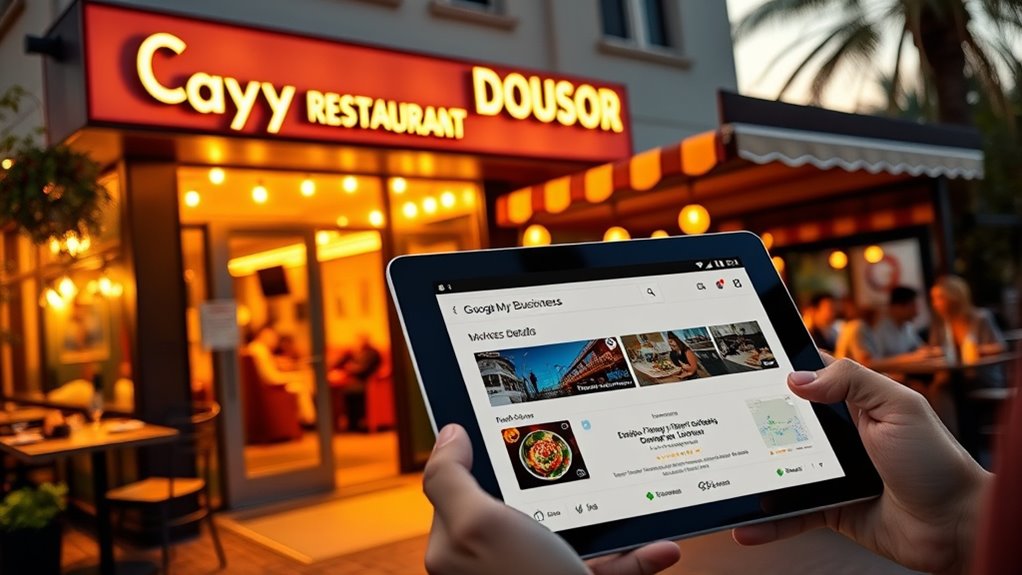
Claiming and optimizing your Google My Business listing is essential for attracting local customers. When you verify your listing, you control the information your potential guests see, making your restaurant more likely to appear in local searches and Google Maps. Confirm your details are accurate—your address, phone number, hours, and website. Add high-quality photos that showcase your dishes and ambiance, as visuals attract clicks. Regularly update your listing with special offers, events, or new menu items to keep customers engaged. Encourage happy customers to leave reviews, boosting your reputation and visibility. Respond promptly to reviews to show you value feedback. These steps help your restaurant stand out in local searches, making it easier for nearby diners to find and choose you. Additionally, understanding family photoshoot fails can remind you of the importance of attention to detail and preparation in managing your online presence.
Use Local Keywords in Your Website Content

To improve your local SEO, you should incorporate neighborhood terms and nearby landmarks into your website content. This helps search engines understand your restaurant’s location and attract local customers. Make sure to naturally include these keywords in your menus, descriptions, and blog posts. Additionally, highlighting any unique features related to local tuning shops can also draw in customers interested in automotive services.
Incorporate Neighborhood Terms
Including neighborhood terms in your website content is essential for local SEO because it helps search engines understand where your restaurant is located and what areas you serve. Use specific neighborhood names naturally within your pages, menus, and descriptions to target local searches effectively. Mention nearby streets, districts, or popular areas customers might search for when looking for a restaurant like yours. Incorporate these terms into headings, meta descriptions, and image alt text to reinforce your local relevance. This strategy not only boosts your visibility in local search results but also appeals to nearby customers actively seeking dining options in their area. Additionally, highlighting the unique features of your location, such as local landmarks or districts, can further enhance your local SEO efforts. Keep your references genuine and contextually relevant to ensure your content remains engaging and useful.
Highlight Local Landmarks
Highlighting local landmarks on your website helps potential customers easily find your restaurant and understand its proximity to well-known sites. Incorporate names of nearby attractions, parks, or iconic buildings naturally into your content. For example, mention that you’re just a block from the city center or near the historic bridge. Use local keywords like “near [landmark]” or “close to [famous site]” to boost your SEO. Including these details not only improves search rankings but also reassures visitors that your location is convenient. Be specific and authentic—avoid vague references. Updating your website with landmark mentions makes it easier for search engines to connect your restaurant with local queries, driving more foot traffic and online visibility. For instance, referencing the urban pursuits in Harrisburg can help attract visitors interested in exploring local cultural activities.
Manage and Encourage Customer Reviews
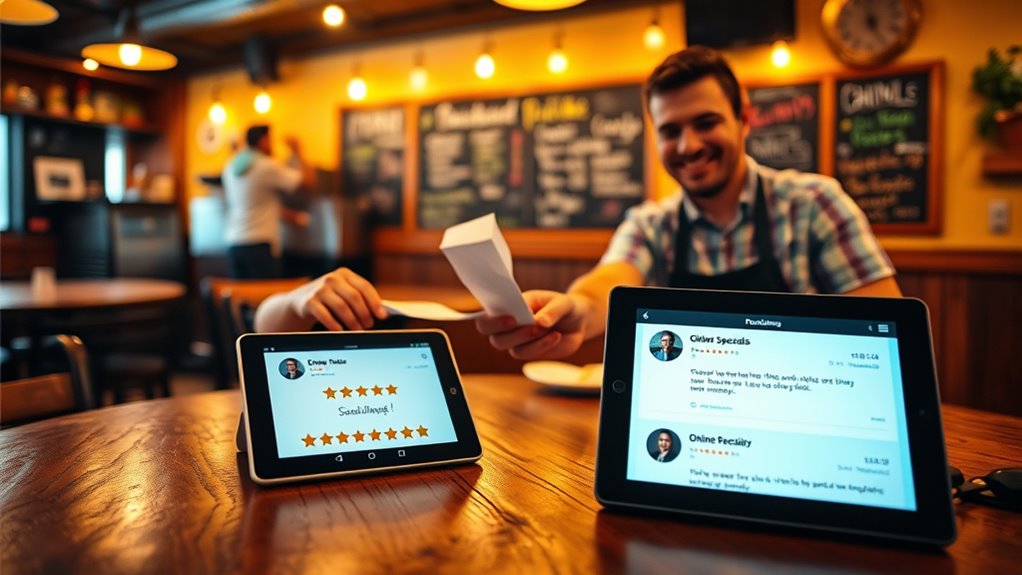
Encourage your customers to share their opinions by asking politely, showing you value their feedback. When reviews come in, respond promptly and professionally to build trust and loyalty. Highlighting positive experiences can also attract new customers and strengthen your online reputation. Incorporating consistent practice techniques in your customer interactions can further enhance engagement and satisfaction.
Request Opinions Politely
As a restaurant owner, politely asking customers for their opinions can considerably boost your online reputation. When you approach diners with genuine gratitude, they’re more likely to share their experiences willingly. Keep your request simple and friendly, such as, “We’d love to hear your feedback.” Avoid sounding pushy or insistent; instead, express that their input helps improve your service. You can also mention that their reviews will help future guests choose your restaurant. Timing is key—ask after they’ve finished their meal, when their experience is fresh. Personalize your request, making it clear you value their opinion. By encouraging reviews politely, you foster goodwill and increase the chances of receiving positive feedback that enhances your local SEO. Incorporating review management strategies can further streamline this process and ensure consistent feedback collection.
Respond Promptly and Professionally
When customers leave reviews, responding promptly and professionally shows that you value their feedback and are committed to excellent service. A quick reply demonstrates your attentiveness and builds trust. Always thank reviewers for sharing their experience, whether it’s positive or negative. Keep your responses polite, sincere, and concise—avoid dismissive language or excuses. If a review highlights a problem, acknowledge it and offer to resolve the issue privately. This approach shows you care about customer satisfaction and are willing to improve. Consistent, professional replies encourage others to share their experiences, boosting your reputation. Remember, your responses are public, so maintain a friendly tone that reflects your restaurant’s values. Effective management of reviews can turn feedback into a powerful marketing tool. Additionally, engaging with reviews related to your local SEO efforts can help improve your online visibility and attract more customers.
Highlight Positive Experiences
Highlighting positive experiences is essential for building your restaurant’s reputation and attracting new customers. When satisfied guests share their positive reviews, it boosts your credibility and shows potential diners that you provide a great experience. Encourage happy customers to leave reviews by politely asking after their visit or including reminders on receipts and menus. Respond to reviews promptly, thanking customers for their feedback and addressing any concerns. Sharing positive reviews on your social media or website also demonstrates your commitment to customer satisfaction. Remember, genuine praise resonates more than generic comments. By actively highlighting these positive experiences, you create social proof that draws in more patrons and strengthens your local SEO efforts. Incorporating reviews and ratings into your marketing strategy can further enhance your online presence and reputation.
Ensure Consistent NAP Information Across Listings

Have you verified that your restaurant’s name, address, and phone number (NAP) are identical across all online listings? Inconsistent information can confuse search engines and customers, hurting your local SEO. To guarantee accuracy, audit every major platform—Google My Business, Yelp, TripAdvisor, and social media profiles—and update any discrepancies. Use a standardized format for your NAP, including abbreviations, suite numbers, and ZIP codes. Consistency signals trustworthiness and improves your chances of ranking higher in local searches. Regularly review your listings to catch any outdated or incorrect details. Remember, even small errors can lead potential customers to the wrong location or prevent them from finding your contact info easily. Keeping your NAP uniform is a simple yet powerful way to boost your local visibility. Additionally, maintaining up-to-date business information across all platforms enhances user experience and trust.
Create Localized Content and Events
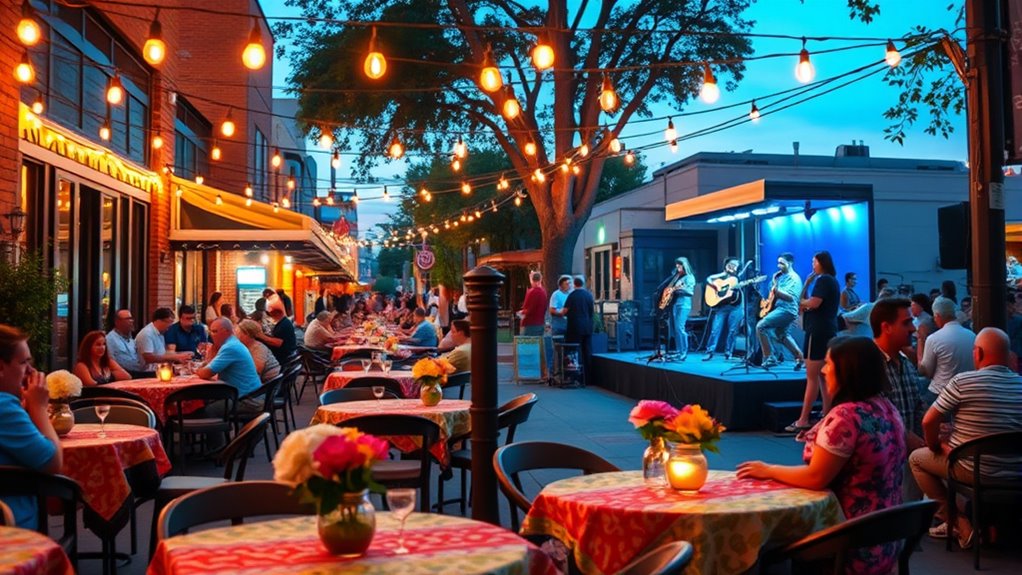
Creating localized content and hosting events tailored to your community can considerably boost your restaurant’s visibility in local search results. Share stories about your neighborhood, feature local ingredients, or highlight staff members from nearby areas. This not only fosters a sense of community but also signals to search engines that you’re an active part of the local scene, attracting nearby customers. Consider organizing events like local food festivals, charity fundraisers, or themed nights that appeal to locals. Promote these events on your website, social media, and local directories. Encourage customers to share their experiences online. By demonstrating your involvement in the community and offering engaging, relevant content and events, you improve your chances of ranking higher in local searches and building strong customer loyalty. Additionally, leveraging automated marketing tools can help streamline your outreach efforts and keep your content fresh and engaging.
Build Local Backlinks and Citations

Building strong local backlinks and citations is essential for boosting your restaurant’s visibility in search results. Backlinks from reputable local websites, such as community blogs, local news outlets, or industry directories, signal to search engines that your business is trustworthy and relevant. To earn these links, consider sponsoring local events or collaborating with nearby businesses. Citations, like listings on Google My Business, Yelp, and other local directories, improve your online presence and help customers find you easily. Guarantee your NAP (Name, Address, Phone number) details are consistent across all platforms. Regularly update your listings and encourage satisfied customers to leave reviews. These efforts strengthen your local authority and make it easier for hungry customers to discover your restaurant.
Optimize for Mobile Search and Voice Queries
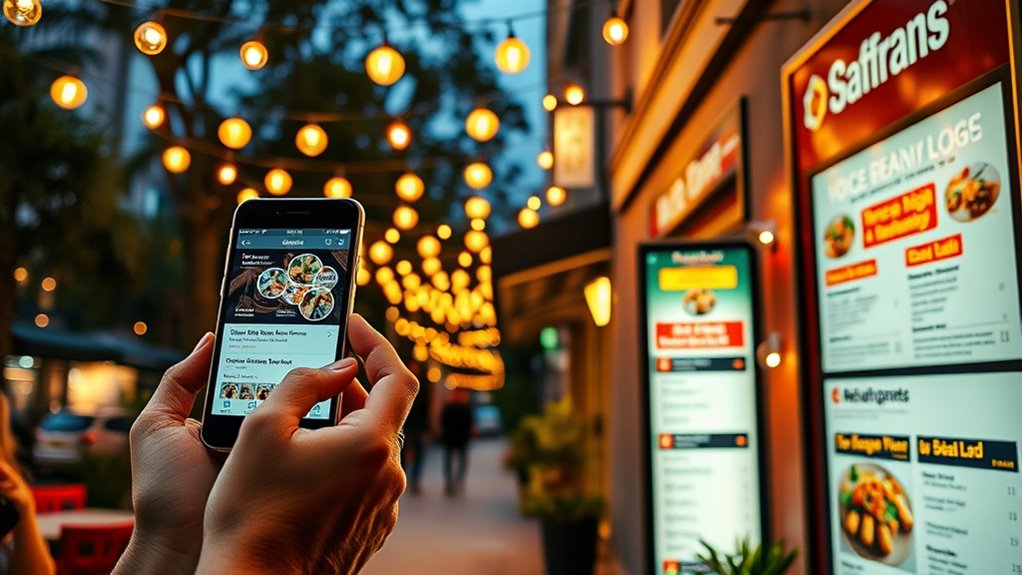
Since more customers are searching for restaurants on their mobile devices and using voice commands, optimizing your online presence for these methods is essential. Ensure your website is mobile-friendly, loads quickly, and features easy-to-navigate menus. Incorporate local keywords naturally into your content and FAQs to match voice search queries. Use structured data to enhance your listing’s appearance in search results. Here’s a quick guide:
| Tip | Action | Benefit |
|---|---|---|
| Mobile Optimization | Use responsive design | Improved user experience |
| Voice Search Keywords | Focus on conversational phrases | Higher local visibility |
| Fast Loading Speed | Compress images and minimize scripts | Reduce bounce rates |
| Local Schemas | Add structured data for menus and hours | Rich snippets, more clicks |
Frequently Asked Questions
How Often Should I Update My Google My Business Profile?
You might wonder how often you should update your Google My Business profile. To stay relevant and attract customers, you should review and update it regularly—at least once a month. Keep your hours, menu, and contact info current, and post updates about special events or offers. By doing this consistently, you improve your chances of ranking higher in local searches and engaging potential customers effectively.
Which Local Keywords Are Most Effective for Restaurant SEO?
When choosing local keywords, you should focus on terms your potential customers are searching for. Think about incorporating your city or neighborhood, plus specific dishes or cuisines you offer. Use tools like Google Keyword Planner to find popular local search terms. Be specific and include variations. This helps your restaurant show up in local searches, attracting nearby diners actively looking for what you serve.
How Can I Handle Negative Reviews Professionally?
Think of negative reviews as storms on your restaurant’s horizon—you can’t prevent them, but you can steer through smoothly. When handling them, respond promptly, politely, and sincerely, like a captain steering through rough waters. Acknowledge their concerns, apologize if needed, and offer solutions. This shows you’re committed to improvement and customer satisfaction. Keeping your tone professional and calm transforms a negative review into an opportunity to showcase your dedication.
What Tools Can Help Track Local Search Rankings?
To track your local search rankings effectively, you can use tools like Moz Local, BrightLocal, or Whitespark. These platforms help you monitor how your restaurant appears in local search results across different locations and keywords. They also provide insights into your competitors and identify areas for improvement. By regularly checking your rankings, you can adjust your SEO strategies to boost visibility and attract more local customers.
How Do I Target Nearby Customers During Off-Peak Hours?
To target nearby customers during off-peak hours, focus on local SEO strategies like updating your Google My Business profile with accurate hours and special offers. Use geo-targeted ads on social media and Google Ads to reach nearby users when you’re less busy. You can also send personalized promotions or discounts via email or social media to entice locals to visit during these slower times, boosting your foot traffic effectively.
Conclusion
Remember, success in local SEO is about planting seeds and nurturing relationships. By claiming your Google My Business, using local keywords, and encouraging reviews, you’re building a strong foundation. Keep your NAP consistent, create local content, and optimize for mobile and voice searches. As they say, “Rome wasn’t built in a day,” but with steady effort, your restaurant will stand out in the local community and attract loyal customers. Stay persistent, and growth will follow.



